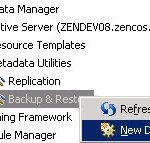The %STPBegin and %STPEnd macros are pretty powerful pieces of code for SAS Stored Processes. They embed all sorts of information on devices, where content is located, and just make everything work. However for creating those fancy custom HTML forms or layouts, ods html is needed instead. I've written about
Author
I must recommend that you check out this example from pg 70 of the SAS Stored Process Developers Guide. http://support.sas.com/documentation/cdl/en/stpug/61271/PDF/default/stpug.pdf This is a pretty sweet example of how to upload a file from your machine (via Internet Explorer) into the SAS System. A custom form can be created in html
You can export the .sas code from a specific task or the entire project into a .sas file! It's great when publishing a project into a repeatable batch/schedule process. However, be aware of default names for the .sas resulting file. I recently ran across an error when exporting a task
The default web application for the Stored Process system takes you to a lovely screen with introductions and samples. However, wouldn't it be nice to skip this screen to just jump right into the stored processes you have created? For 9.2, change the following URL to include your server/port name. This
So you are viewing your SAS Web Report and find that all the data elements capitalizations have changed - instead of no caps or all caps, everything is prop cap (or at least PROPCASE). This is actually a default option in Information Map Studio. To turn it off, select Tools
So you have an idea to implement queries or changes in the metadata via a program directly using SAS. Well, one of the first items of business is actually to grab the Repository ID number. Included below is some quick reference code on how to query that. PROC METADATA SERVER="my_sas_srv_name"
Interested in adding a group of users into Metadata w/o Management Console? Included is an example of how to add one user: PROC METADATA SERVER="my_sas_srv_name" PORT=8561 USERID="sasadm@saspw" PASSWORD="xxxxxxxx" PROTOCOL=BRIDGE in="<AddMetadata> <Metadata> <Person Desc='Manager of clinical studies.' Name='Joe E. Doe' Title='Manager of Clinical Studies'> </Person> </Metadata> <Reposid>A0000001.A5VLFKMC</Reposid> <NS>SAS</NS> <Flags>268435456</Flags> <Options/> </AddMetadata>";
The easiest option is to simply move your 9.2 format catalog to Lev1/SASApp/SASEnvironment/SASFormats/formats.sas7bcat. But you can also modify your SASv9.cfg configuration file to point to a different location: -set fmtlib1 "E:sharedformats" -fmtsearch (fmtlib1.formats) So e:sharedformats is a shared location for the format catalog, and formats (filename formats.sas7bcat) is the name
It is definitely easier to force single selections for prompts used in SAS Stored Processes, however it isn't very usable when the majority of users need to select multiple values. For example, let us say we create a prompt for region (called 'region_prompt') and then use that in the query

I was struggling with a calculated member that completes a distinctcount of members in a dimension, the performance was simply unacceptable. After attempting several other measures such as count(), processing changes on the source data, etc, I sent out a msg on Twitter asking for advice. Once again, why aren't

A user who is a member of the "SAS Administrators" group and has been granted the role "Management Console: Advanced" can create a Metadata Backup job via SAS 9.2 Management Console. Right Click on 'Backup and Restore' Task under 'Metadata Utilities'. Then select the Backup task created and choose either
The SAS 9.2 XML engine is very very very slick. I created an xml map to generate a dataset from xml generated during a metadata getobjects job to then run call execute statements for a proc metalib update. "Wait, you did what??!@#?&" you ask? Here are my simple steps. This
We recently ran into a situation where a customer, with metadata and compute servers on Linux and mid-tier on windows, was trying to leverage the out-of-the-box Pluggable Authentication Module (PAM) support of SAS 9.1.3. PAM allows SAS customers to keep their user management simple by granting users on a Linux
In SAS Management Console, administrators have the ability to include multiple user authentication models (ie user name/pwd combinations) for a single Metadata user account in the 'Accounts' tab. Administrators would then organize these by the Authentication Domain definition in SAS Management Console. The 'DefaultAuth' is the initial account used (unless
We recently confirmed (via http://support.sas.com/forums/forum.jspa?forumID=10&start;=0) that SAS Enterprise Guide does not support proxy servers between itself and SAS servers (metadata, workspace, stored process, etc). However, if the proxy server can be transparent then EG can work through it. While implementing SAS BI at a customer site we needed to access
SAS Enterprise Guide allows users to access files on the SAS server environment. Only one of the three options can be set - either to point to the designated user folder 'SAS User Root', set to the root 'System Root', or define a shared location/directory 'path'. The SAS Administrator sets
Using the proc metalib process to update specific elements would generate errors related to the base SAS Library conflicting with the Metalib referenced library. You can run a libname _all_ list; statement to review all the libraries available to the process. Also, the reference material utilized to improve the process
Within SAS Run the following code (the purple text is the password you would like to encode): proc pwencode in='myn3wpwd4u'; run; After submitting this code (F3), the resulting encoded password in available only in the log file. The results from this example are below, the highlighted line is the encrypted
I’ve never found a great user guide, not to say that one doesn’t exist. You should be able to schedule any type of executable/job like a batch file from using the Platform LSF client tools (packaged with the server tools). You can also use command line executables like bsub and
The data table creation date is sometimes necessary, say in the footnote of your stored process. Included below is a sample to retrieve this date from the file system. /*Open the dataset*/ %let dsid=%sysfunc(open(sashelp.shoes)); data _null_; /*grab the CRDTE function*/ ddate=%sysfunc(attrn(&dsid;,CRDTE )); /*Format in DDMONYY*/ call symput('ddate', put(ddate, dtdate9.)); run;
(Thanks Alan for passing this along!)
Special Character problems in passwords continue to cause issues, and many organizations require the use of at least 1 to pass security requirements. Specific ones to stay away from ... @ ... Just today this caused problems in remote connections to Meta Engine Libname. & ... This can affect users
If your SMC or other metadata-based SAS tools seem to take a long time to load up when connecting to the metadata server you may benefit from running a reorg. The %OMABAKUP macro includes a reorg parameter which reduces the amount of fragmentation in how the datasets making up SAS
So you have installed the SAS System, and you can check what is licensed with the proc setinit command, but what if something hiccuped in the install. Or your supporting (I mean validating) someone else's install and you need to quickly see what is available? Included below is some 'found'
For BI Installations, a SAS Service Configuration Utility is available to manage your sas services in a window's environment. Go to Start->Programs->SAS->SAS 9.1 Utilities->SAS Service Configuration Utility. You can install, remove, and set options on the Windows Services. (Thanks goes to Bryan for pointing neat utility out.)
Today, I needed to figure out how to create a simple measure for OLAP and have it available to the users. Fortunately, EG has a great Create New Measure GUI for this! It creates the MDX code on the fly! Okay, bear with me. There are several steps to this,
Here is a code snippet I came up with today to save output with various _odsoptions AND allow the users to choose what type of output they need: RTF, PDF, or HTML. (Note that this will default to PDF if the user doesn't pick anything. Also there is a report
Enterprise Guide has a wonderful OLAP Viewer if you don't/can't use the web stuff. I went to the SAS Course 'Creating and Exploiting OLAP Using the SAS System' which has in the Course Notes some great steps on using EG for OLAP Viewing. Basically, the 'Tasks by Category' menu has
When developing the business intelligence measures, you have to be entirely cognizant of the behaviors you could promote. For instance, in measuring and setting business objectives for number of defects per line of code, developers could write more lines of code to reduce the calculated result or they could document

